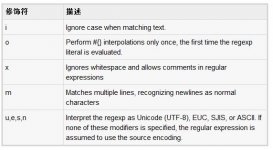前言:
在學(xué)習(xí)model關(guān)聯(lián)之前,首先要牢記一下幾點(diǎn):
1.關(guān)聯(lián)關(guān)系,兩端都要寫(xiě)好,否則會(huì)出現(xiàn)初學(xué)者看不懂的錯(cuò)誤。而且對(duì)于理解代碼,非常有好處。
2.model的名字是單數(shù),controller是復(fù)數(shù)。
3.blong_to后面必須是單數(shù),而且必須是小寫(xiě)。has_many后面必須是復(fù)數(shù)。
一:一對(duì)多
例如:
王媽媽有兩個(gè)孩子,小明和小亮。可以說(shuō),王媽媽,有多個(gè)孩子。也可以說(shuō):小明,有一個(gè)媽媽;小王,有一個(gè)媽媽。我們一般在設(shè)計(jì)表的時(shí)候,是這樣設(shè)計(jì)的:
mothers表中id和name
sons表中有id和name
為了增加邏輯關(guān)系,主外鍵關(guān)系,會(huì)在多的一方,增加一列,所以sons表中有三列,id和name和mother_id(對(duì)應(yīng)了mothers表的id)
普通SQL:
|
1
|
select test_associate.mothers.name from test_associate.mothers inner join test_associate.sons on sons.mother_id = mothers.id where sons.name = '小李' |
ruby代碼:
|
1
2
3
4
5
6
7
|
class Mother has_many :sonsendclass Son belongs_to :motherend |
解釋:一個(gè)媽媽又多個(gè)孩子,一個(gè)兒子屬于一個(gè)媽媽。
我們?cè)趓ails console可以測(cè)試下:
xiao_wang = Son.first
mom = xiaowang.mother
這個(gè) .mother 方法就是由 class Son的belongs_to :mother這句話生成的。
也就是相當(dāng)于轉(zhuǎn)換成了一下的sql語(yǔ)句:
|
1
2
3
4
|
select * from mothers join sons on sons.mother_id = mothers.id where sons.id = 1 |
詳細(xì)解釋:
A:belongs_to :mother
B:belongs_to :mother, :class => 'Mother', :foreign_key => 'mother_id'
A=B
這個(gè)就是Rails最典型的根據(jù)慣例來(lái)編程,聲明哪個(gè)表對(duì)應(yīng)的是哪個(gè)class,再在class之間聲明好關(guān)聯(lián)關(guān)系。
1.belongs_to :mother, rails就能判斷出: mothers 表,是一的那一端。 而當(dāng)前class 是: "class Son", 那么rails 就知道了 兩個(gè)表的對(duì)應(yīng)關(guān)系。
2.:class => 'Mother', 表示, 一的那一端, 對(duì)應(yīng)的model class是Mother. 根據(jù)rails的慣例, Mother model對(duì)應(yīng)的是 數(shù)據(jù)庫(kù)中的 mothers 表。
3.:foreign_key => 'mother_id', rails就知道了, 外鍵是 'mother_id'. 而一對(duì)多關(guān)系中, 外鍵是保存在 多的那一端(也就是 sons, 所以說(shuō),在 sons表中, 必須有一個(gè)列, 叫做: mother_id )
所以, 這個(gè)復(fù)雜的SQL 條件就齊備了, 可以生成了。
上面的ruby代碼,配置好之后, 就可以這樣調(diào)用:
|
1
2
3
4
|
son = Son.firstson.mother # .mother方法, 是由 class Son 中的 belongs_to 產(chǎn)生的。mother = Mother.firstmother.sons # .sons 方法, 是由 class Mother 中的 hash_many 產(chǎn)生的。 |
二:一對(duì)一,比較簡(jiǎn)單,也不常用,這里不介紹。(老公和老婆)
三:多對(duì)多
例如:
一個(gè)學(xué)生,有多個(gè)老師,(學(xué)習(xí)了多門(mén)課程)
一個(gè)老師,可以教多個(gè)孩子(教一門(mén)課程,但是有好多學(xué)生來(lái)聽(tīng)這個(gè)課程)
我們往往會(huì)這樣做:
students有id和name兩個(gè)字段
teachers有id和name兩個(gè)字段
放在任何一個(gè)表中都不合適,這是我們需要一張中間表,也就是橋梁表。
lessons有id和name和student_id和teacher_id
原始SQL:
|
1
2
3
4
5
6
7
|
select teachers.*, students.*, lessons.* from lessons from teachers , join teachers on lessons.teacher_id = teachers.id join students on lessons.student_id = students.id where students.name = '小王' |
Ruby代碼:
|
1
2
3
4
|
class Student has_many :lessons has_many :teachers, :through => :lessonsend |
提示:has_many :teachers, :through => :lessons 相當(dāng)于
has_many :teachers, :class => 'Teacher', :foreign_key => 'teacher_id', :throught => :lessons
class Teachers
has_many :lessons
has_many :students, :through => :lessons
end
查看小王的老師有哪些,同上面的原始SQL語(yǔ)句。
|
1
|
Student.find_by_name('小王').teachers |
以上就是本文給大家分享的全部?jī)?nèi)容了,給出的示例也非常的簡(jiǎn)單易懂,希望大家能夠喜歡。
原文鏈接:http://www.jianshu.com/p/ed91f63d9ae4







